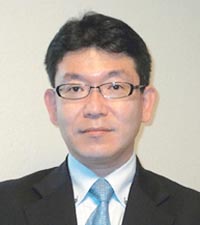Home > About Us > Sustainability Management > Sustainability Report > Sustainability Report 2012 > Third-Party Comment
 Third-Party Comment
Third-Party Comment
Comments on reading the Kobe Steel Group's Sustainability Report 2012

General Manager
Environmental Initiative and Corporate
Social Responsibility Support Department
Development Bank of Japan
PROFILE
Keisuke Takegahara graduated from Hitotsubashi University Faculty of Law and joined Japan Development Bank (now Development Bank of Japan) in 1989. He went on to work as Deputy Director of the Policy Planning Department (in charge of planning environmental investment), and as Manager of the CSR Promotion Office (Business Development Department) before being appointed to his current position. Previous posts have included part-time graduate school lecturer at the University of Tokyo, member of the Ministry of Economy, Trade and Industry's Study Committee on the Evaluation of Environmental Capabilities in the Financial Market and member of the Ministry of the Environment's Review Committee for Industries and Services subject to Surveys into the Scale of Environmental Business Markets and Employment. Since 2009, he has also been a member of the Central Environmental Council General Policy Committee's Specialist Committee on Finance and the Environment.
Reading the Kobe Steel Group Sustainability Report 2012, I was struck that this year's CSR report has been much improved over last year's edition. Going beyond last year's focus on "cooperation with the local community," the Kobe Steel Group has broadened its horizons to focus on "contributing to society." There is a clear emphasis on monozukuri in particular, a keyword that runs throughout the report, underlining the way in which the group views its relationship with society. This also helps the content as a whole to flow together more organically than previously. It would be fair to say that this year's report really clarifies the Kobe Steel Group's concept of CSR management.
This concept is embodied most clearly in the special feature at the start of the report. The feature looks at both disaster prevention and recovery technologies, based on "protecting people through monozukuri," and a wide range of energy-saving and energy-creating technologies, as typified by the group's Microbinary system. Dealing with topics of current interest such as these effectively captures the Kobe Steel Group's commitment to innovation across a wide range of sectors.
The social section of the report comes back to the same concept. As well as recognizing that providing outstanding products and services is a crucial part of the group's social dimension, the report emphasizes the group's underlying monozukuri-ryoku, or manufacturing capabilities, in terms of continually providing trustworthy technologies, products and services. This is an important message that runs consistently throughout the report. Compared to last year, the group has significantly expanded the report's social content in various different ways. The social section begins by clarifying the group's relationships with its stakeholders for instance, and also takes an in-depth look at the group's ongoing community oriented activities in other countries. This is another of the key features of this year's report.
Although the report still relies on specialist knowledge to some extent, the group has been trying to include readers who may not have such specialist knowledge for several years now, by making material flow charts, divisional environmental impact data and other figures easier to understand. Those efforts are really starting to show through. Including photos alongside comments from employees and other stakeholders meanwhile is a very nice touch that gives the report a sense of individuality.
Although improvements such as these reflect stakeholders' needs on the whole and deserve a great deal of praise, I would say that there is still room for improvement in one respect. The report tends to shy away from references to the group's supply chain, which is something that a lot of companies are focusing on at the moment and an area of great public interest. References to energy-saving initiatives in distribution allude to all the hard work being done in this area, and the Kobe Steel Group clearly has advanced technological capabilities that could help prevent overexploitation of limited resources, epitomized by ITmk3®. With that in mind, the group really needs to spell out its philosophy and position with regard to its supply chain.
I commented that last year's report was the Kobe Steel Group's most complete sustainability report to date. The group's 2012 report however is an even more complete package, revolving clearly around universal concepts that capture the Kobe Steel Group's spirit of "contributing to society through monozukuri."
Editorial Postscript
![]()
In the Kobe Steel Group Sustainability Report 2012, we have made a conscious effort to communicate our unique contribution activities, as a global manufacturer, to a wide range of stakeholders as simply as possible. The opening special feature on "Contributing to Society Through Monozukuri" looks at various different technologies, from disaster prevention and recovery to generating electricity and gas from surplus energy. This year's report also features an environmental close-up on the "Kobelco Environment Creation Fund" and a social close-up on our "Global Social Contribution Activities." In addition to all that, we have gone out of our way to ensure that the report explains our approach as a group as clearly as possible, by actively including content such as photos, graphs and people's comments. We look forward to receiving honest feedback from readers, as we strive to make our reports even more comprehensive in the future.


